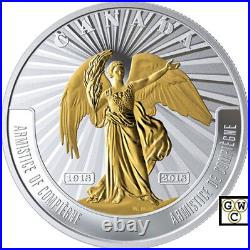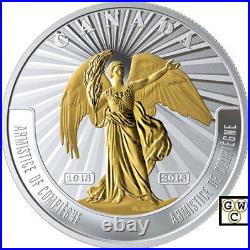
The Canadians who have fought so gallantly for our liberties and those of the world, and who have given to our country a great place among the world’s nations, will return to Canada with a wider vision and with a higher appreciation of the opportunities that lie before them. Sir Robert Borden. On November 11, 1918, the battlefields suddenly fell silent after four calamitous years that forever changed the world. The armistice signed near Compiègne, France, marked the beginning of the end of the First World War, as diplomatic wrangling replaced armed conflict in the quest for a much-desired peace that, sadly, would prove to be imperfect and short-lived. Far beyond re-defined borders, the story of Canada in the First World War is one of mud-soaked valour and misery in the trenches; of the introduction of new combat tactics and the modern machinery of war; and of individual contributions and collective sacrifices that led to the costly allied victory. When our combatants came home in 1919, they found a Canada that had been transformed by the war experience, emerging as fledgling nation whose international reputation was forged in battle at places such as Neuve-Chapelle, Ypres, the Somme, Passchendaele and Vimy, and during Canada’s Hundred Days. Commemorate Armistice with a’winged’ tribute to all who served in the First World War. EIGHTH AND FINAL COIN IN OUR FIRST WORLD WAR: BATTLEFRONT SERIES. Our First World War: Battlefront series comes to a close with a final tribute to the Canadians and Newfoundlanders who bravely served in the Great War: the winged figure from the Victory Medal, which followed us on every step of this collectible journey. Previous coins in this eight-coin series all featured the winged figure from the 1919 Victory Medal as a design flourish; here, its gold-plated, sculpted beauty highlights the legacy of those who bravely served in a war that transformed Canada and shaped the 20th century. Slightly larger than the bronze-cast Victory Medal, this pure silver coin combines modern engraving techniques and finishes to bring the classic-styled allegory to life. FEATURES A HISTORIC EFFIGY. Like all Canadian coins minted between 1914 and 1918, the coins in this retrospective series feature the effigy of King George V by Sir E. MacKennal, but with a touch of selective gold plating to add a golden shine. The beauty box for your coin is the final piece to complete the set! When all eight coins are placed spine to spine, the boxes provide a timeline of the major Canadian battles of the First World War. The reverse commemorates the centennial of the armistice signed near Compiègne, France, on November 11, 1918-an agreement that ended the fighting across the Western Front. The full-length view of this classic-styled allegory finds Victory standing with her left arm raised, her right hand holding a palm branch; behind her, engraved rays that represent hope for a peaceful future fill the field and heighten the luminous nature of the sculpted design. The reverse includes the words “CANADA” engraved above the figure, along with the double dates “1918 – 2018″ that mark the centennial, and the bilingual “title” of this final chapter in the story of Canada on the battlefields of the First World War. In March 1919, the 13 allied nations agreed to an idea proposed by Marsal Ferdinand Foch, the supreme commander of the allied forces, who called for a common award honouring those who served in the First World War. Patterned on a French medal honouring the combatants of the Franco-Prussian War, each Victory Medal (also known as the Inter-Allied Victory Medal) was to be made of bronze, with the same diameter (36 millimetres) and a double rainbow ribbon, and a national design offering a take on the traditional winged figure of Victory. The Victory Medal awarded to Canada and other forces within the British Empire was authorized on September 1, 1919. The Victory Medal was Issued with the British War Medal and given to all ranks of Canada’s fighting forces, as well as civilian contractors and those employed with military hospitals, provided they had served in a theatre of war between August 5, 1914, and November 11, 1918. A total of 5,725,000 Victory Medals were issued, including 351,289 awarded to members of the Canadian Expeditionary Force (CEF). Each recipient’s name, number and rank were engraved on the rim. The proposed name for the medal was “The Allies’ Medal, ” but a more inclusive “Victory Medal” was adopted instead, since it would apply to allied and associated nations who fought on the side of the Triple Entente. Victory Medals issued within the British Empire (including Canada) show the winged figure of Victory with her left arm raised and a palm branch in her right hand. Those whose meritorious actions were mentioned in an official report were awarded an oak leaf “Mentioned in Despatches” emblem, to be worn on the Victory Medal’s rainbow ribbon. This distinction was awarded to 25 members of the Royal Newfoundland Regiment. There were a few notable design variations between the allies, including: a reverse text in English and Dutch on the medal issued by the Union of South Africa; an ancient warrior instead of the winged figure on the Japanese medal; and the image of a deity on Siam’s (Thailand) medal. Your coin is encapsulated and presented in a Royal Canadian Mint-branded maroon clamshell with a graphic beauty box. 99.99% pure silver. Proof with selective gold plating. William McMillan (reverse), Sir E. This item is in the category “Coins & Paper Money\Coins: Canada\Commemorative”. The seller is “gatewestcoins” and is located in this country: CA. This item can be shipped to Canada, United States.
- Circulated/Uncirculated: Uncirculated
- Denomination: $20
- Fineness: 0.9999
- Country/Region of Manufacture: Canada
- Certification: RCM

